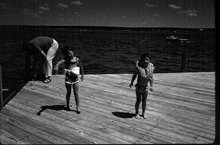
H.C. Pipkin, Little Red River, 1947
*from Adrienne Rich, The Desert as Garden of Paradise
By 1970 the town was nothing more than a small oasis in a sea of dust and corn. The old Victorian courthouse in the center of town with its clock tower and pitched roof had already burned to the ground twice after being struck by lightning. It had been replaced in the '50s with an industrial-looking concrete structure with bare slab walls whose sole decoration was a series of large black and white photographs of the Dustbowl--entire farms being consumed by a cloud of thick sand as high as a thunderhead. She would often stand for hours in the dimly-lit halls of the courthouse--it had no windows--staring in wonder at the images behind the glass. The new courthouse stood in the shadow of the tall grain elevators blocks away on the edge of town, and was flanked on all sides by the drugstore, the Post Office, and the T.G. and Y. The bank and grocery store were less than a block away. By fall of 1970, the population was just reaching two thousand.
The site for the town had been surveyed in 1848 by Clovis Handstock, a twenty-one year old Virginia native who, to his credit, sensed an unusual vibration when he stood alone on the prairie near Old Salt Creek. As he slept at night beneath an intricate web of stars, his dreams tended toward the mythological--he dreamed history in reverse, a future unraveled before his eyes like a sweater. He dreamed of the Dustbowl and a Kiowa war chief and a solitary girl dreaming of him, somewhere far off, in a house where she waited her whole life for a man with wings.
Soon afterwards the first settlers began to arrive, mostly immigrants of German descent with a strong reverence for God and nature, who did not anticipate the capricious nature of the wind, nor had they yet encountered the particularly deadly breed of tornado indigenous to the Panhandle. For generations to come they would battle dust and wind, and they would drink from wells dug deep down into the heart of the limestone channel where prehistoric water had coursed beneath the surface of the prairie for millenia. It would be many generations before they realized that the source they plundered to irrigate their crops and feed their livestock and wash their automobiles and flush their toilets, was an irreplaceable vein, rare and pure, and possessing of strange properties. By 1970, travelers driving north or south on the new highways which cut across the flat earth like surgical incisions, could not but admire the tenacious and resourceful farmers whose arcs of shimmering water spouted from monolithic, mobile sprinklers beneath the unforgiving midday sun.
(from The Penetrable Air)
water
“it is no place of seed, or of figs, or of vines, or of pomegranates”
-Numbers 20:5
you would come to understand that
though you stood at the river for a long time
you could not drink.
there was a language of such vessels
devised in vain hope to stave off thirst:
cistern, well, jar, broken cup
each syllable falling hollow on the throat
of a dying bird
others would simply adapt to lack--wretched species
wanting after every drop
but never hiding from the wind, or dreaming of rivers
but of cottonwood and white seed that covered the blanket of a sleeping child,
high in the mountains…
If there were water
And no rock
If there were rock
And also water
And water
A spring
A pool among the rock
If there were the sound of water only
Not the cicada
And dry grass singing
But sound of water over a rock
Where the hermit-thrush sings in the pine trees
Drip drop drip drop drop drop drop
But there is no water
(-T.S.Eliot “The Wasteland”)
…only
thirst.



